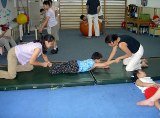Home Exercises For Cerebral Palsy
| |
|
Can Exercises help in Cerebral Palsy?
While there is not yet a cure for cerebral palsy, there are exercises that can be performed to increase flexibility, strengthen constricted muscles, and improve one's quality of life.
Cerebral palsy, meaning "brain paralysis," is the term used for a group of disorders that affect movement, posture, and balance.
Cerebral palsy is caused by damage or abnormal development in one or more areas of the brain that control motor activity and muscle tone.
Stretching Exercises
Stretching is a basic exercise used by cerebral palsy patients to slowly loosen tight muscles in a way that doesn't cause pain.
To properly stretch, have an assistant hold the stretched extremity for several seconds. Each extremity should be stretched two to three times during each warm-up.
Patients who are not capable of standing on their own should use supports or an assistant for safety purposes.
Weight Resistant Exercises
Performing weight resistant exercises is an excellent way to make use of your own body weight to create resistance.
Weight wrist bands, small dumbbells, and ankle bands are idea for beginners. Patients should only use the amount of weight that they can safely handle to avoid damage or strain to the muscles.
Patients should begin gradually with 5 repetitions for each extremity and slowly increase to 10 as they become more comfortable with the exercise.
Aerobic Exercises
Cerebral palsy can respond positively to aerobic exercises, whether it be standing or chair aerobics.
Those who are capable can try various types of aerobic exercise, such as walking, jogging, dancing, or stair climbing. These exercises help to improve circulation and maintain muscle strength and flexibility.
Chair aerobics can be performed when the patient sits in a chair while working out their upper body. The use of a regular routine can improve muscle tone and breathing.
Cycling Exercises
Arm and leg cycling use a motion similar to pedaling a bicycle. Stationary cycling units, known as Erogmeters, can be used indoors to improve range of motion, flexibility, and endurance.
Participants can practice cycling on a two or three wheel powered vehicle outdoors or on a stationary bicycle indoors. These machines are outfitted with hand-controlled gears to increase or decrease intensity when desired. Both arm and leg cycling promotes healthy heart and lungs while increasing efficiency.
Ball Exercises
Ball exercises provide patients with cerebral palsy the flexibility to perform a wide range of exercise routines with the help of a fitness ball.
Nearly all of these exercises require the user to stabilize the ball by engaging his core. Common exercises that include the use of a fitness ball include crunches, planks, lunges, bridge, leg lifts, and side exercises.
A series of yoga poses can also be performed using the ball as support. These help to stretch the inner thighs, hips, and back. As with all exercise, the user should practice proper body alignment to avoid injury.
Aquatic Exercises
Aquatic exercise is beneficial to cerebral palsy patients as they are less strenuous on the joints.
Shallow water walking or running mimics land walking but with 12 times the endurance. Patients should practice walking with extended legs, long strides, and corresponding arm movement in water up to the waist or chest.
Shallow water movement increases coordination and metabolism with virtually no pain.
DISCLAIMER: As with any new exercise or activity, consult a qualified physician prior to beginning.
Back to top of Cerebral Palsy exercises at home
